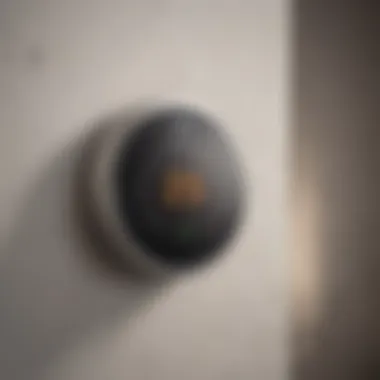Unlocking the Future: Smart Home Innovations


Overview
Foreword to the topic
The advent of smart home technology has shifted the paradigm of residential living. From automated lighting systems to advanced security protocols, these innovations promise not just convenience but also sustainable living. This article explores the expansive capabilities of such technology, framing the context around convenience, security, and energy efficiency.
Brief background information
Over the last decade, smart home devices have become increasingly integrated into everyday life. Devices such as Google Nest, Amazon Echo, and Philips Hue are just a few examples of how technology has transformed home environments. This transformation has implications ranging from energy conservation to enhanced safety, leading consumers to reconsider their living spaces.
Key Features of Smart Home Technology
Smart home technology encompasses a wide range of devices, each with unique features and specifications.
- Automation: Devices can operate autonomously, responding to environmental conditions or user commands.
- Integration: Many devices connect seamlessly with each other, creating cohesive ecosystems.
- Remote Access: Users can monitor and control devices from their smartphones or tablets, even when away from home.
- Energy Monitoring: Some devices provide real-time feedback on energy usage, empowering users to optimize consumption.
Pros and Cons
Advantages
- Increased convenience through automation.
- Enhanced security with surveillance cameras and smart locks.
- Potential cost savings on energy bills.
- Customization options tailored to user preferences.
Disadvantages
- Initial setup costs can be high.
- Dependence on internet connectivity for optimal performance.
- Privacy concerns related to data collection from smart devices.
User Experience
Real-world experiences with smart home technologies vary widely. Many users report feeling more secure and connected.
"Having the ability to lock my doors remotely has completely changed how I feel about home security," one user shared on Reddit. Others, however, express frustration over technical issues. Connectivity problems and device compatibility can detract from the overall experience.
Buying Guide
When considering investing in smart home technology, potential buyers should take several factors into account:
- Performance: Evaluate the reliability of the devices through reviews and user feedback.
- Value for Money: Assess whether the features align with pricing. Devices should offer clear benefits relative to their costs.
- Compatibility: Ensure that devices can integrate with existing systems, especially if expanding an already established smart home.
Understanding Smart Home Technology
Understanding smart home technology is essential in comprehending the broader implications it has on modern living. This section emphasizes the significance of these advancements as they pertain to improving daily life. Smart home technology integrates various devices and systems that communicate with one another, optimizing convenience, security, and energy efficiency. As households increasingly rely on digital solutions, a firm grasp of smart home technology enhances user experience and promotes informed decisions regarding adoption.
Definition and Overview
At its core, smart home technology pertains to the automation of household tasks through networked devices. This includes items like smart lighting, thermostats, appliances, and security systems that can be controlled remotely via smartphones or voice commands. These devices utilize various communication protocols such as Wi-Fi, Zigbee, and Bluetooth, creating an interconnected ecosystem that simplifies home management.
The appeal of smart home technology goes beyond mere automation. It offers enhanced control over environments and operations. For example, homeowners can remotely monitor energy consumption or receive notifications when unusual activity is detected on their property. This capability not only provides peace of mind but can lead to considerable energy savings as well.
Historical Context
The evolution of smart home technology can be traced back to the early devices introduced in the 20th century aimed at increasing household convenience. The introduction of programmable thermostats marked a significant milestone in this journey. However, the true transformation began with the advent of the internet and the rise of wireless communication technologies in the late 1990s and early 2000s.
The emergence of smartphones further accelerated this trend. As consumers embraced mobile technology, they began integrating these devices with home systems. This created a demand for more sophisticated smart home solutions. By the 2010s, major tech companies, such as Google and Amazon, entered the smart home market with products like the Google Home and Amazon Echo. Today, smart home technology is at a point where not only can it enhance convenience but also contribute to safety and energy management on a large scale.
"Smart home technology is not merely a trend; it represents a shift in how we interact with our living environments."


In summary, understanding smart home technology is crucial as it impacts various facets of modern living. It represents an intersection of convenience, efficiency, and innovative technology, making it a notable topic of discussion for anyone involved in tech advancements.
Key Components of Smart Homes
Understanding the key components of smart homes is essential for grasping how this technology shapes modern living. The integration of various devices enhances the functionality of a home. Each element plays a role in improving convenience, increasing security, and optimizing energy efficiency.
Smart Sensing Devices
Smart sensing devices are foundational to the smart home ecosystem. These devices collect data about the environment, household activities, and user preferences. Sensors can monitor anything from door openings to temperature changes. For instance, motion detectors alert homeowners of activity, aiding security. Moreover, temperature sensors in smart thermostats can learn user habits, leading to a more efficient heating and cooling process.
Key benefits of smart sensing devices include:
- Real-time data collection: Continuous monitoring allows for immediate assessment of various home parameters.
- Increased automation: Many devices trigger actions based on sensor data. For example, lights turn on when someone enters a room.
- Improved energy consumption: Sensors help optimize energy use, reducing bills and environmental impact.
In the context of a smart home, these devices are crucial for creating a responsive and adaptive living space.
Automated Controls
Automated controls are the mechanisms that connect different smart devices. These controls facilitate seamless interaction among gadgets, making the home environment more user-friendly and efficient. An example of this is a centralized hub, like the Google Nest Hub, which can manage various smart features from a single interface.
Automation enhances user experience in several ways:
- Schedule settings: Homeowners can set routines, such as automatically turning off lights at midnight.
- Remote operation: Devices can be controlled from anywhere via smartphones, which increases flexibility and convenience.
- Inter-device communication: Automated systems allow devices to communicate. For instance, when a smart smoke detector goes off, lights may blink to alert residents.
The importance of automated controls cannot be overstated. They bridge the gap among devices and significantly enhance user control and comfort.
Interconnectivity
Interconnectivity refers to the ability of different devices to communicate with each other. This concept is vital for creating a cohesive smart home environment. When devices are interconnected, they work together to provide a more integrated experience. For example, smart lighting systems can adjust based on the time of day or user presence, enhancing ambiance with little to no manual effort.
Benefits of interconnectivity include:
- Enhanced functionality: Devices that work together can offer features that single devices cannot, like programmed scenes for entertainment.
- Simplified management: Homeowners can manage all their smart devices through one app, reducing complexity.
- Improved responsiveness: Interconnected systems adapt in real-time to changes in the environment or user commands, providing instant responses.
In summary, interconnectivity sets the foundation for a truly smart home where comfort, security, and efficiency coexist.
Smart Home Devices
Smart home devices represent a pivotal aspect of the modern home ecosystem. They facilitate seamless interactions and enhance our living environment through automation, convenience, and efficiency. This section elaborates on the specific devices that comprise a smart home, focusing on their unique functionalities and benefits. Understanding these devices is essential for tech enthusiasts who wish to create an integrated, intelligent home.
Smart Assistants
Smart assistants are becoming central to smart home experiences. Devices such as Amazon Echo and Google Home allow users to control various features of their homes via voice commands. This includes music playback, setting reminders, and, significantly, managing linked smart devices. The integration of natural language processing empowers these assistants to learn and evolve, becoming more attuned to individual user preferences over time.
Considerations when selecting a smart assistant include compatibility with existing devices, voice recognition capabilities, and privacy settings. Many users appreciate the hands-free convenience that allows multitasking while controlling home environments. Yet, concerns over data privacy and unauthorized access are prevalent, necessitating a careful evaluation of security measures.
Security Systems
Security is a foremost concern for homeowners, and smart security systems offer innovative solutions. Brands like Ring and Arlo provide comprehensive monitoring through cameras, doorbell systems, and motion sensors. These devices not only alert users about suspicious activities but also allow remote viewing on smartphones.
The advantages of smart security systems extend beyond mere alerts. They often integrate with other smart devices, such as lights and locks, enhancing the overall security framework of the home. A key consideration for potential buyers is the robustness of the app and support services, ensuring reliability in critical situations.
Smart Lighting Solutions
Smart lighting solutions contribute significantly to energy efficiency and ambiance in homes. From Philips Hue to LIFX, these products allow users to control lighting through smartphone applications or voice commands. Adjusting brightness and colors can create the desired atmosphere for different occasions.


A primary benefit of smart lighting is energy efficiency. Users can schedule lights to turn off when not in use or dim them based on natural light levels, thereby saving electricity. However, compatibility with other smart home devices and setup complexity should be accounted for during selection.
Thermostats and Climate Control
Thermostats and climate control systems are crucial for maintaining comfort while optimizing energy usage. Devices like the Nest Learning Thermostat learn from user behavior to adjust heating and cooling automatically. They enable users to set schedules and monitor energy consumption through apps.
The key advantage is improved comfort and convenience. These devices can respond to real-time environmental changes, maintaining optimal conditions without manual intervention. Additionally, it's important to assess whether the device can integrate with other smart home technologies, ensuring a unified management system.
Home Appliances
Smart home appliances enhance everyday tasks and add convenience. From washing machines that can be monitored remotely to refrigerators that can keep track of food inventory, the impact is profound. Brands such as Samsung and LG offer a variety of smart appliances that make household management easier.
The integration of smart appliances into the home ecosystem allows for streamlined operations. Users can receive alerts about cycle completion or maintenance issues directly on their devices. Before making a purchase, buyers should consider the interfaces’ ease of use and the range of features available to ensure maximum utility in daily life.
"The integration of smart devices can lead to significant reductions in energy consumption, improved security, and enhanced convenience for users."
Benefits of Smart Home Integration
Integrating smart home technology into everyday life significantly enhances different aspects of living. This integration not only streamlines daily tasks but also contributes to safety and sustainability. Understanding the benefits provides insight into why many households are adopting such technologies. This further underscores the relevance of smart home integration in modern home setups.
Enhanced Security
Smart homes offer improved security through advanced monitoring systems and automation. Devices such as smart cameras, motion detectors, and doorbell cameras empower homeowners to oversee their properties remotely. These tools can detect unusual activity and send real-time alerts.
One such system, the Ring Video Doorbell, allows users to visually check who is at the door, even if they are not home. This promotes both peace of mind and a deterrent against potential intruders.
With automated lighting solutions, homeowners can simulate presence, acting as a safety measure. Lights programmed to turn on and off throughout the day can help to prevent break-ins by creating the illusion of occupancy.
"Smart home security solutions provide quick responses to potential threats, increasing overall property safety."
Energy Efficiency
Energy efficiency is another significant advantage of smart home technology. Smart thermostats like the Nest Learning Thermostat learn your schedule and adjust your home’s temperature accordingly. This leads to lower energy consumption, reducing utility bills over time.
In addition to temperature control, smart lighting systems enable users to optimize energy use by allowing lights to turn off when a room is not in use. Philips Hue bulbs can be controlled through a smartphone app, ensuring light is only used when necessary.
Adoptions of energy-efficient practices facilitated by smart home devices contribute positively to the environment. They can lower carbon footprints by minimizing energy waste in daily usage.
Convenience and Comfort
The increased convenience provided by smart technology allows for a more comfortable living environment. Smart assistants like Amazon Alexa or Google Assistant enable hands-free control over various devices. Homeowners can adjust settings, play music, or get information without needing to physically interact with devices.
Smart home appliances enhance daily life significantly. For instance, the Samsung Smart Fridge can suggest recipes based on available ingredients, while the iRobot Roomba cleans floors autonomously. These conveniences free up time for other essential activities.
Moreover, the automation of tasks adds to overall comfort. Just imagine waking up to a gently increasing light or a coffee machine brewing as you prepare for the day. This level of comfort transforms day-to-day experiences into smoother, more enjoyable routines.
Remote Access and Monitoring
With remote access, homeowners can control various aspects of their homes from anywhere using their smartphones. This capability includes adjusting temperature settings, checking security camera feeds, or even managing smart locks. This is particularly useful for people who travel frequently or for those who want heightened control over their daily household dynamics.
Home automation systems like SmartThings offer comprehensive app-based control, allowing users to monitor and manage energy use, security, and other home functionalities.
This constant monitoring capability gives homeowners more confidence in their ability to protect their property and manage their energy consumption effectively. Moreover, remote access effectively reinforces a sense of control, which many find essential in leading a modern, busy life.
Challenges in Smart Home Adoption


Smart home technology offers numerous advantages, yet it faces significant challenges that may hinder its widespread adoption. Addressing these challenges is crucial for understanding the current landscape of smart homes, as well as recognizing the potential obstacles that consumers might encounter. It is important to explore specific elements like privacy concerns, compatibility issues, and initial investment costs. These factors not only influence consumer decisions but also shape the overall market for smart home devices and their integration.
Privacy Concerns
As smart homes become increasingly prevalent, privacy concerns have emerged as one of the foremost issues. Users rely on various connected devices that often collect, process, and transmit personal data. For instance, smart assistants like Amazon Alexa and Google Home track usage patterns and preferences. The data gathered can lead to customized experiences, but it also raises questions about data protection and unauthorized access.
Security breaches in connected devices can expose sensitive information, such as schedules, routines, or even personal conversations. Many consumers fear that their private lives could be compromised. According to a 2022 survey, over 60% of respondents voiced concerns about how their data would be used and who would have access to it. Therefore, manufacturers must prioritize robust security measures, transparency regarding data usage, and data-sharing policies to build trust with potential users.
Compatibility Issues
Another significant hurdle is compatibility issues among different devices and ecosystems. As the smart home market evolves, many products come from various manufacturers utilizing differing protocols and communication standards. For example, devices from Philips Hue may not seamlessly integrate with a Nest thermostat without the use of third-party applications or hubs. This fragmentation creates roadblocks for users who desire an easy and unified experience.
Homeowners often face tedious installation processes or must invest additional time and money to connect devices that should work together. As a result, this complexity discourages users from fully committing to smart home technology. A consistent effort among manufacturers to establish common standards and interoperability protocols will be vital for reducing consumer frustration and encouraging greater adoption.
Initial Investment Costs
Initial investment costs represent another barrier when it comes to adopting smart home technology. Many consumers are concerned about the hefty price tags associated with various smart devices. Top-tier products often come with advanced features but may not fit into every budget. For example, a high-quality smart security system can easily reach several hundred dollars, while energy-efficient smart thermostats also add to the overall expense.
In some cases, potential users might hesitate to invest in smart homes due to uncertainty about long-term savings from energy efficiency or security benefits. Consequently, this skepticism can delay the decision-making process, limiting market growth. To counteract this, manufacturers need to offer a range of products at different price points, as well as demonstrate tangible benefits to justify the initial investment. Offering financing options or bundling devices could also make smart home technology more accessible.
"Understanding the challenges in smart home adoption is vital, as overcoming them could lead to a broader acceptance and integration of these technologies into everyday life."
Overall, acknowledging these challenges paves the way for better solutions. Considerations regarding privacy, compatibility, and costs can lead to a more robust environment for smart home technology, ultimately enhancing user experience and market viability.
Future Trends in Smart Home Technology
As smart home technology continues to evolve, understanding future trends becomes crucial for both consumers and industry stakeholders. These trends not only highlight the direction of innovation but also reflect the changing demands of users in terms of convenience, security, and energy management. Recognizing these advancements allows tech enthusiasts and consumers to make informed decisions when integrating smart devices into their homes.
Advancements in Artificial Intelligence
Artificial Intelligence (AI) plays a pivotal role in the evolution of smart home technology. Devices equipped with AI have the potential to learn user habits over time, significantly enhancing their responsiveness and utility. For instance, smart thermostats can adjust temperatures based on the user’s daily routines, leading to comfortable living conditions while optimizing energy consumption.
Moreover, AI facilitates more sophisticated home assistants, such as Amazon Alexa and Google Assistant. These systems can analyze voice commands more effectively, enabling users to control their smart devices with greater accuracy and efficiency. As AI continues to improve, we can expect more seamless interactions between users and their smart home environments, fostering a truly personalized experience.
Integration with Internet of Things (IoT)
The integration of smart home technology with the Internet of Things (IoT) signifies a leap towards a fully connected living space. IoT allows various devices to communicate and coordinate with one another, making it easier for users to manage their homes. A smart fridge, for example, can communicate with a smart oven, suggesting recipes based on available ingredients.
This level of connectivity enhances the overall functionality and convenience of smart homes. Users can remotely monitor their homes through apps, receive notifications regarding security or appliance status, and manage energy consumption more efficiently. For tech enthusiasts, staying aware of IoT advancements means exploring new possibilities to automate daily tasks, ultimately leading to a more efficient lifestyle.
Sustainability Initiatives
Sustainability is becoming an increasingly vital consideration in smart home technology. Many consumers are looking for solutions that not only enhance comfort but also contribute positively to the environment. Manufacturers are responding by developing energy-efficient devices that reduce energy consumption and minimize waste.
For example, innovative smart lighting systems can automatically adjust brightness based on natural light levels, reducing electricity usage. Furthermore, smart irrigation systems can optimize water usage in gardens, promoting sustainable landscaping practices.
The focus on sustainability in smart home technology reflects a broader societal shift towards environmentally conscious living, highlighting the role of advanced technology in reducing our carbon footprint.
Ending
The conclusion acts as a pivotal element of this article, synthesizing the insights shared and reflecting on the implication of smart home technology. Understanding the capabilities of smart home systems is essential, not only for tech enthusiasts but for anyone seeking to enhance their living environments with innovative solutions. This technology holds the power to transform homes into more efficient and automated spaces.
Summary of Key Insights
The exploration into smart home capabilities reveals several significant aspects. Smart home technology encompasses a diverse range of devices and systems that operate interdependently to enhance daily life. From smart assistants like Amazon Echo to advanced security systems like Ring, each device serves a purpose that contributes to the overall functionality of the home. The integration of these devices via platforms like Google Home and Apple HomeKit allows users to manage their environment seamlessly.
Moreover, benefits emerge clearly throughout the article. Enhanced security features provide peace of mind. Energy efficiency not only reduces costs but also supports sustainability efforts. Convenience improves user experience, allowing for remote monitoring and control of various home aspects.
Final Thoughts on Smart Home Capabilities
In summary, as we look to the future, smart home capabilities will continue to evolve. The advancements in artificial intelligence and integration with the Internet of Things underscore a trend toward more responsive and intuitive home systems. These innovations remind us of the importance of embracing technology that aligns with our daily needs. As homeowners or potential investors in this technology, understanding the nuances, benefits, and potential challenges will ensure that we make informed decisions.
Smart home technology is not simply a luxury; it is becoming increasingly essential. From energy management to enhanced comfort and safety, the role of smart homes in modern life cannot be underestimated. As you consider these aspects, the potential to elevate your living experience is within reach.







